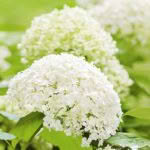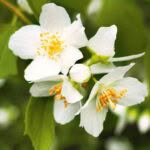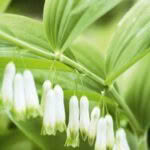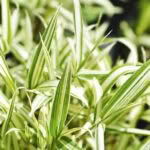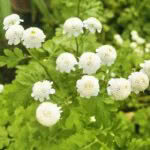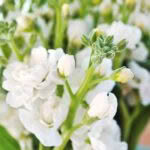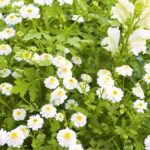How to turn your garden into a blooming wonderland of white flowers
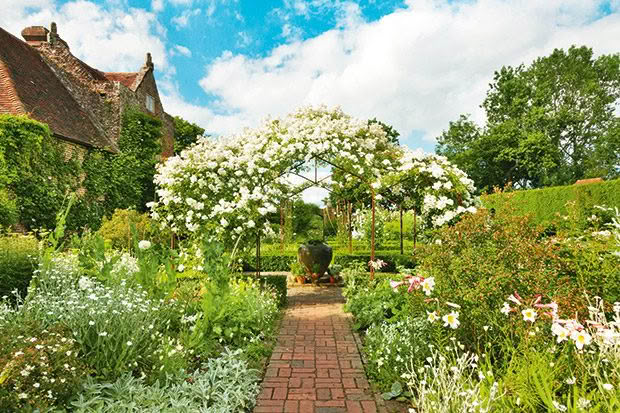
White gardens are beautiful day and night, but even the most famous one in the world is a mix of colours, and that’s all-white.
Words: Jane Wrigglesworth
This is the famous White Garden. It’s 70 years old, and more than 200,000 people a year still wander through it. Its creator, Vita Sackville-West, wasn’t aiming to create a one-colour garden fashion, but it’s now forever linked to her name and Sissinghurst Castle Garden.
“I am trying to make a grey, green, and white garden,” she wrote in the Observer in 1950. “This is an experiment that I ardently hope may be successful, though I doubt it. One’s best ideas seldom play up in practice to one’s expectations, especially in gardening.”
She visualised white trumpet lilies emerging from grey southernwood, artemisia, and cotton lavender, not all-white. “I don’t want to boast in advance about my grey, green, and white garden. It may be a terrible failure. I only wanted to suggest that such experiments are worth trying.”
- Blooming Solomon`s seal Polygonatum odoratum.
- Hydrangea arborescens Incrediball.
- Philadelphus coronarius.
What subsequently became known as the White Garden was an instant hit, initiated a white-bloom movement, and remains a popular garden style today. If you were to call half a dozen landscapers, they’d all say the same thing: a white garden is relaxing.
Another wonderful characteristic of a white garden is that the flowers are luminous under the moon’s glow. In my garden, a kahikatea covered in silver-white lichen glows in the moonlight, its trunk lit up like a beacon.
Vita loved this too. She designed her garden to be at its best in early July (mid-summer in the UK) “especially in the evenings or when illuminated by a full moon”. Her choice of plants was varied. “Artemisia, the silver Cineraria maritima, grey santolina and Achillea ageratifolia.
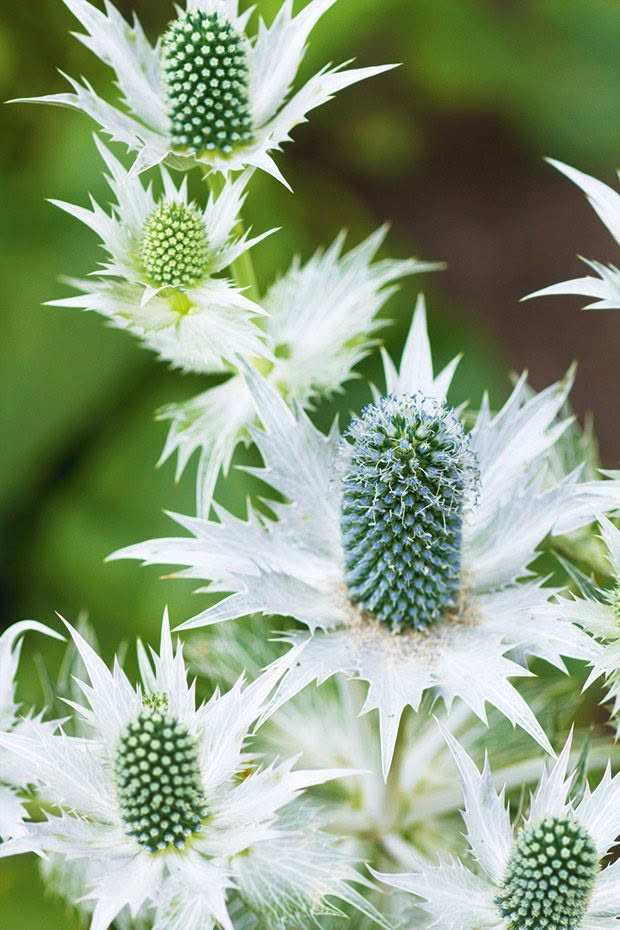
“These are pierced with the upright white trumpets of Lilium regale and the white spires of eremurus, foxgloves and delphiniums.
“There are shrubs to add volume and structure; Hydrangea grandiflora, a white cistus, Paeonia suffruticosa subsp. rockii and Buddleia nivea, as well as trees such as Hippophae rhamnoides, Pyrus salicifolia Pendula, and almond trees lining the central path.
“The giant Arabian thistle Onopordon arabicum surges up eight feet into the air whilst foamy gypsophila softens the planting.”
How to plant a great white garden
1. CONTRAST
The simplicity of a white garden means the designer doesn’t have to worry about colour clashes. They can concentrate on contrasts in plant form, texture, and structure. Tall perennials work with squat ground covers; pompom-shaped flowerheads go with spiked leaves.
1A. INCORPORATE A DARK BACKGROUND
A red brick wall or wooden garden screen provide some contrast, but black, dark greys or deep greens make a white flower palette really pop. Good options include black fences, blue-toned grey screens, or dark-green hedging, such as box or Chilean guava (which in NZ means you also get edible berries).
- Pleioblastus variegatus.
- Tanacetum parthenium.
2. ADD HEIGHT
Vita Sackville-West chose a weeping silver pear (Pyrus salicifolia Pendula) for the centre of her garden, and almond trees for their white spring blossoms. Silver and grey shrubs and topiary add interest when there’s no flowers.
Climbing plants on pergolas and archways provide a textured background, highlighting their white blooms or those of the plants around them.
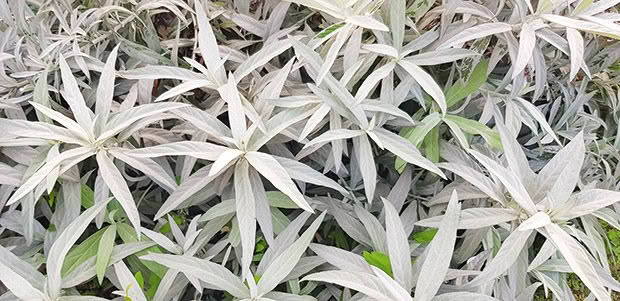
3. 50+ SHADES OF WHITE
White gardens are never all-white. Shimmers of grey, silver, and pale green provide highlights and lowlights. Even the whites vary.
There’s pure white, off-white, blue-white, white with a green-yellow undertone, white with a pink blush. Many shades of white look better than just pure white, which can make a garden look too stark.
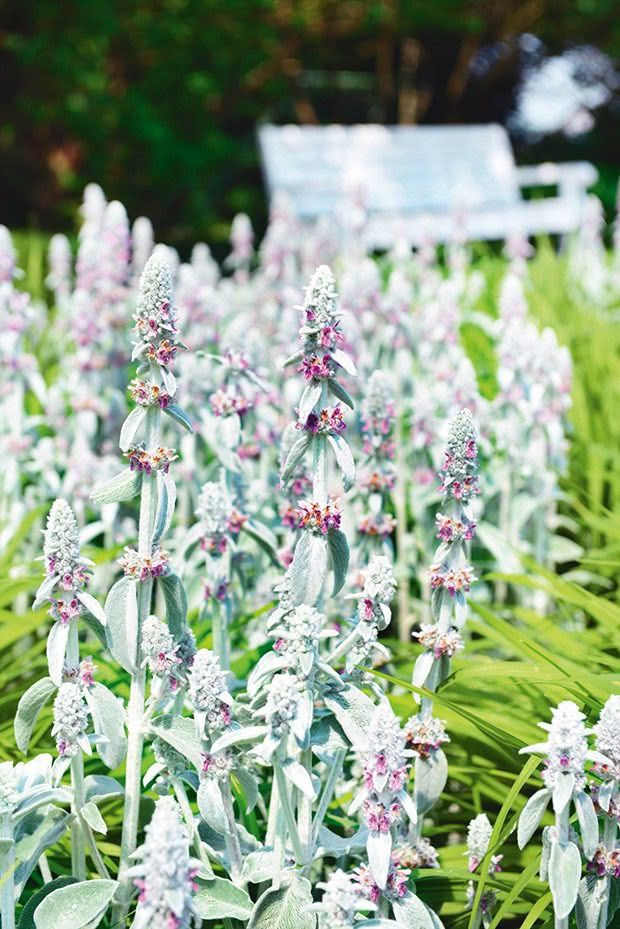
4. VARY IT
Options: hostas, brunneras
Plants with variegated white foliage provide white accents when summer flowers finish blooming. If you want only white blooms, choose your hostas and brunneras carefully, or pick the flowers, as they’re often pink, lilac (hostas) or blue (brunneras).
Variegated Solomon’s seal (Polygonatum odoratum Variegatum) has beautiful silver foliage, and white, bell-shaped blooms that dangle from arched stems in spring.
5. CHOOSE WHITE FOR ALL SEASONS
When selecting plants, try to choose ones that give you flowers in every season. If you can’t find something to bloom in a particular month, incorporate annuals.
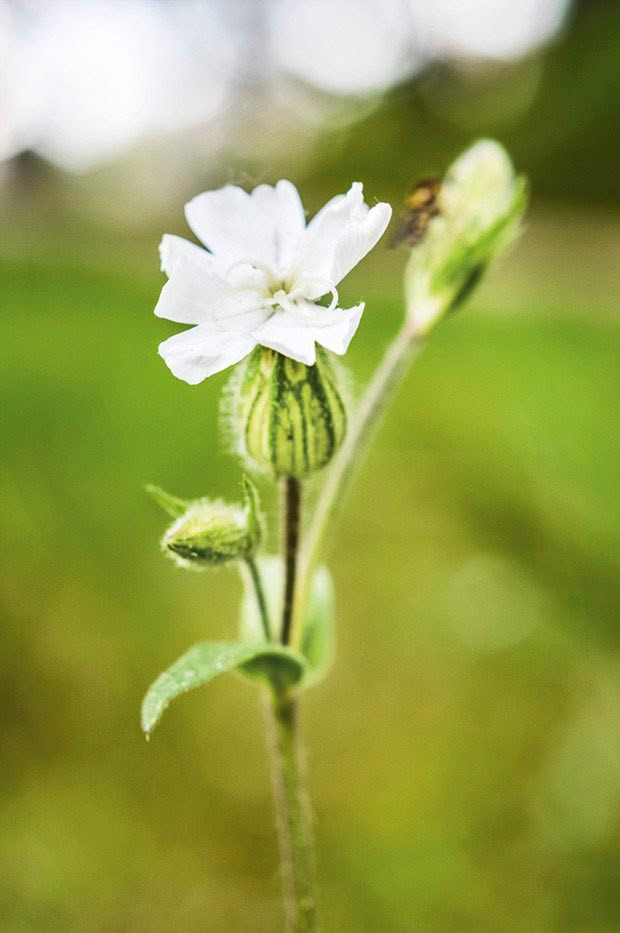
Winters: white polyanthus, fairy primula (Primula malacoides)
Late summer-autumn: asters
Spring-autumn: stock (Matthiola)
Jane’s tip: If you put in pathways, don’t go for white, such as shell or pebbles, as it detracts from the flowers. A light, neutral colour is best.
FOUR SHADES OF GREY
Silver and grey-leafed plants were an essential part of Vita Sackville-West’s White Garden design, for their elegance, and because they work so well with white.
Four good options:
1. Luminous sea holly, Eryngium giganteum Miss Willmott’s Ghost
2. Artemisia ludoviciana
3. Lamb’s ears, Stachys byzantina
4. White rose campion, Lychnis coronaria Alba
- Stock, Matthiola.
- Asters.
- Snow In Summer, Cerastium tomentosum.
47 PLANTS FOR WHITE GARDENS
PERENNIALS
• Astrantia major
• bleeding heart, Dicentra spectabilis Alba
• chincherinchee, Ornithogalum thyrsoides
• clematis
• delphiniums
• Dianthus Mrs Sinkins
• Eryngium giganteum Miss Willmott’s Ghost
• feverfew, Tanacetum parthenium
• foxtail lily, Eremurus
• granny’s bonnet, Aquilegia
• lily of the valley, Convallaria majalis
• lupins
• perennial candytuft, Iberis sempervirens
• rose campion, Lychnis coronaria Alba
• shasta daisy, Leucanthemum x superbum
• Snow-in-summer, Cerastium tomentosum
• Solomon’s seal, Polygonatum odoratum Variegatum
• Verbascum phoeniceum Flush of White
• white lavender
• white lily, Lilium
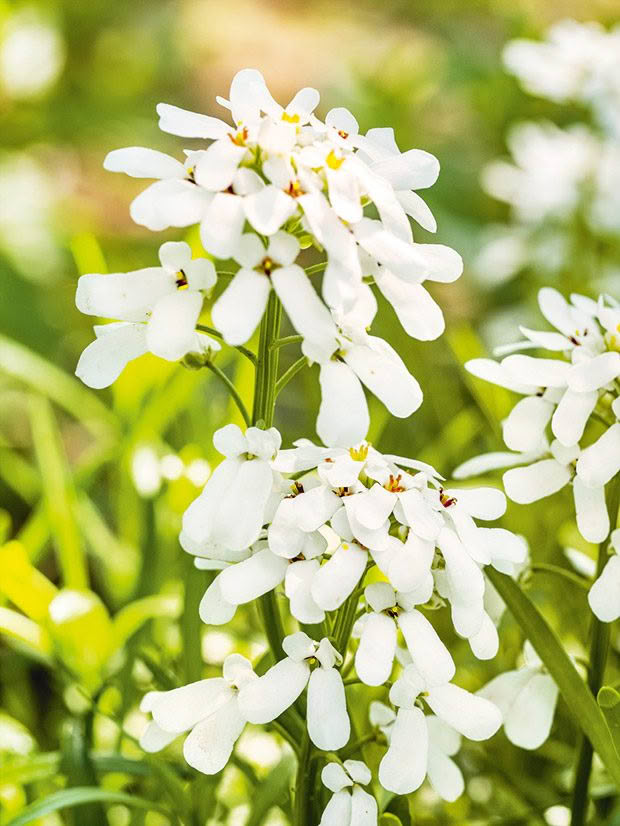
Evergreen Candytuft, Iberis sempervirens.
BIENNIALS
• foxglove, Digitalis purpurea Alba
• sweet rocket, Hesperis matronalis Alba
• variegated honesty, Lunaria annua Variegata
Annuals
• alyssum, Lobularia maritima
• annual candytuft, Iberis armara
• cosmos, Cosmos bipinnatus
• dusty miller, Centaurea cineraria
• gypsophila, Gypsophila elegans
• larkspur, Delphinium consolida
• Nicotiana sylvestris
• stock, Matthiola incana
• Zinnia elegans
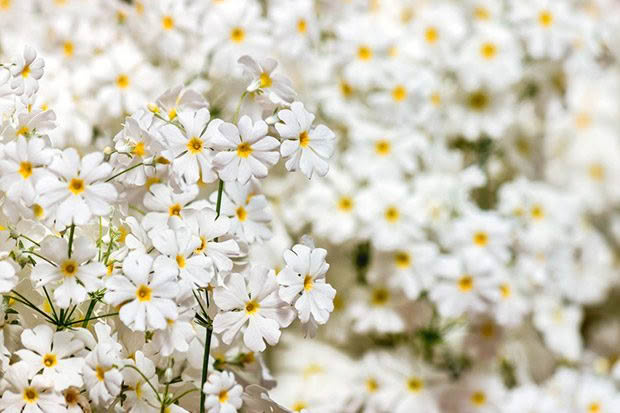
Fairy primula.
SHRUBS
• Buddleja Silver Anniversary
• Deutzia gracilis
• hydrangea
• lilac, Syringa
• mock orange, Philadelphus virginalis
• rhododendrons
• rose
• silverbush, Convolvulus cneorum
• spirea, spiraea
• viburnums
• white Spanish broom, Cytisus Albus
FOLIAGE PLANTS
• Artemisia
• Lamb’s ears, Stachys byzantine
• Pleioblastus fortunei Variegata
• White-variegated hosta
Love this story? Subscribe now!
 This article first appeared in NZ Lifestyle Block Magazine.
This article first appeared in NZ Lifestyle Block Magazine.
